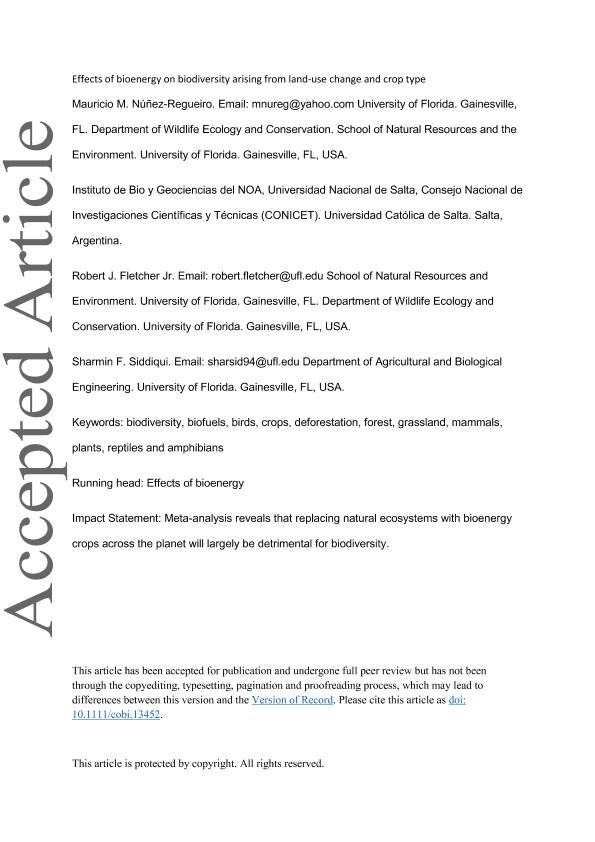Mostrar el registro sencillo del ítem
dc.contributor.author
Nunez Regueiro, Mauricio Manuel

dc.contributor.author
Siddiqui, Sharmin F.
dc.contributor.author
Fletcher, Robert J.
dc.date.available
2020-12-17T04:25:19Z
dc.date.issued
2019-12-19
dc.identifier.citation
Nunez Regueiro, Mauricio Manuel; Siddiqui, Sharmin F.; Fletcher, Robert J.; Effects of bioenergy on biodiversity arising from land-use change and crop type; Wiley Blackwell Publishing, Inc; Conservation Biology; 2019; 19-12-2019; 1-32
dc.identifier.issn
0888-8892
dc.identifier.uri
http://hdl.handle.net/11336/120690
dc.description.abstract
Understanding how the world's flora and fauna will respond to bioenergy expansion is critical. This issue is particularly pronounced considering bioenergy's potential role as a driver of land‐use change, the variety of production crops being considered and currently used for biomass, and the diversity of ecosystems that can potentially supply land for bioenergy across the planet. We conducted 2 global meta‐analyses to determine how 8 of the most commonly used bioenergy crops may affect site‐level biodiversity. One search was directed at finding data on biodiversity in different production land uses and the other at extracting energy‐yield estimates of potential bioenergy crops. We used linear mixed‐effect models to test whether effects on biodiversity varied with different individual bioenergy crop species, estimated energy yield, first‐ or second‐generation crops, type of reference ecosystem considered, and magnitude of vertical change in habitat structure between any given crop and the reference ecosystem. Species diversity and abundance were generally lower in crops considered for bioenergy relative to the natural ecosystems they may replace. First‐generation crops, derived from oils, sugars, and starches, tended to have greater effects than second‐generation crops, derived from lignocellulose, woody crops, or residues. Crop yield had nonlinear effects on abundance and, to a lesser extent, overall biodiversity; biodiversity effects were driven by negative yield effects for birds but not other taxa. Our results emphasize that replacing natural ecosystems with bioenergy crops across the planet will largely be detrimental for biodiversity, with first generation and high‐yield crops having the strongest negative effects. We argue that meeting energy goals with bioenergy using existing marginal lands or biomass extraction within existing production landscapes may provide more biodiversity‐friendly alternatives than conversion of natural ecosystems for biofuel production.
dc.format
application/pdf
dc.language.iso
eng
dc.publisher
Wiley Blackwell Publishing, Inc

dc.rights
info:eu-repo/semantics/openAccess
dc.rights.uri
https://creativecommons.org/licenses/by-nc-sa/2.5/ar/
dc.subject
AMPHIBIANS
dc.subject
ANFIBIOS
dc.subject
AVES
dc.subject
BIOCOMBUSTIBLES
dc.subject
BIODIVERSIDAD
dc.subject
BIODIVERSITY
dc.subject
BIOFUELS
dc.subject
BIRDS
dc.subject
CROPS
dc.subject
CULTIVOS
dc.subject
DEFORESTACIÓN
dc.subject
DEFORESTATION
dc.subject
FOREST
dc.subject
GRASSLAND
dc.subject
MAMMALS
dc.subject
MAMÍFEROS
dc.subject
PASTIZALES
dc.subject
PLANTAS
dc.subject
PLANTS
dc.subject
REPTILES
dc.subject
REPTILES
dc.subject.classification
Otras Ciencias de la Tierra y relacionadas con el Medio Ambiente

dc.subject.classification
Ciencias de la Tierra y relacionadas con el Medio Ambiente

dc.subject.classification
CIENCIAS NATURALES Y EXACTAS

dc.title
Effects of bioenergy on biodiversity arising from land-use change and crop type
dc.type
info:eu-repo/semantics/article
dc.type
info:ar-repo/semantics/artículo
dc.type
info:eu-repo/semantics/publishedVersion
dc.date.updated
2020-11-20T17:28:38Z
dc.identifier.eissn
1523-1739
dc.journal.volume
2019
dc.journal.pagination
1-32
dc.journal.pais
Reino Unido

dc.journal.ciudad
Londres
dc.description.fil
Fil: Nunez Regueiro, Mauricio Manuel. University of Florida. Department of Wildlife Ecology and Conservation; Estados Unidos. Consejo Nacional de Investigaciones Científicas y Técnicas. Centro Científico Tecnológico Conicet - Salta. Instituto de Bio y Geociencias del NOA. Universidad Nacional de Salta. Facultad de Ciencias Naturales. Museo de Ciencias Naturales. Instituto de Bio y Geociencias del NOA; Argentina. Universidad Católica de Salta; Argentina
dc.description.fil
Fil: Siddiqui, Sharmin F.. University of Florida. Department of Wildlife Ecology and Conservation; Estados Unidos
dc.description.fil
Fil: Fletcher, Robert J.. University of Florida. Department of Wildlife Ecology and Conservation; Estados Unidos
dc.journal.title
Conservation Biology

dc.relation.alternativeid
info:eu-repo/semantics/altIdentifier/doi/https://doi.org/10.1111/cobi.13452
dc.relation.alternativeid
info:eu-repo/semantics/altIdentifier/url/https://conbio.onlinelibrary.wiley.com/doi/abs/10.1111/cobi.13452
Archivos asociados
